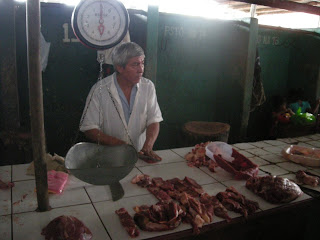 |
| Livestock feet for sale at the market in Tarapoto, Peru. |
 |
| A woman stands at her booth in the market at Tarapoto. She is selling fish, which have been cured by salting them. |
At the interview for my job at The News 10 years ago, the
editors asked me where I wanted to eat for lunch.
Somewhere that serves beef, I told them.
They chuckled, probably thinking that was appropriate for an
agricultural reporter, then took me to the now closed Amarillo Grill.
I have 100 percent faith in our U.S. Department of
Agriculture. Our food supply is the safest in the world and my present trip to Peru
makes me appreciate the stringent rules and regulations of our government.
Since our Kansas Agriculture and Rural Leadership class tour
of Peru
started, the cuisine has been interesting. Peruvians eat a lot of protein like
chicken. They eat a ton of potatoes. And, of course, there are plenty of fruits
here in this country south of the Equator.
Lunchtime typically consists of three course, the first two
usually including potatoes. Then, most working class folks, it seems, takes a
siesta.
There have been a lot of good meals here in the country,
especially when you’re a meat and potatoes gal like me. However, while I might
not be as adventurous as some when it comes to cultural dining, my appetite has
turned quickly off after touring a market in the jungle city of Tarapoto, which
has a population that exceeds 60,000.
Inside, vendors with booths about the size you’d see at the
Kansas State Fair, if not smaller, lined walkways. Their counters were covered
in proteins like raw beef, pork and chicken, as well as fish.
The fish seemed to be well salted, but everything else
appeared at room temperature amid a hot and steamy jungle environment, which
included dust and flies, no gloves, room-temperature meat – obviously everything
for which our food inspectors would not issue a license.
We then sat down for lunch. A hamburger was on the menu, but
I ruled that out fast. The safest bet was either French fries or maybe pizza.
Yes, I have become nearly a vegetarian, living, at present,
on a diet of French fries and ice cream. At least half our KARL class has (or
still is) battled illness since Sunday. As for myself, knock on wood, I’m still
healthy, thanks maybe to picky eating,
along with the countless breakfast bars and peanuts I packed before I left.
And, yes, I am trying a little bit of everything - for the most part.
And, yes, I am trying a little bit of everything - for the most part.
I can’t wait to get home and have a juicy steak produced by
our Kansas
ranchers who work hard to produce a good and yummy quality product they put into the food
supply. I can’t wait to have some bread – much of which is grown in Kansas, milled, more than likely, in Newton,
Stafford or Wichita
and put on our shelves in Dillons.
Obama plans to cut food inspections this summer as part of
the sequester. Will the move affect our safe food supply? Probably not. Still,
a tour of a third-world country food market would have any lawmaker second-guessing
such a decision.
We still have several days left in our cultural
enlightenment as we move into the highlands of Peru.
And we still haven’t been served our meal of guinea pig.
 |
| This is a potato sandwhich, in essence. Two slices of potato between chicken. |
 |
| This was a great meal my first night in Chincha, fried chicken pieces dipped in a lime sauce. |
 |
| Norky's I guess, is one of the famous chain Peruvian chicken houses. It was good. |
 |
| Another meat market photo of raw beef being sold in the market.I just couldn't stomach the rows and rows of beef being sold this way. |
No comments:
Post a Comment